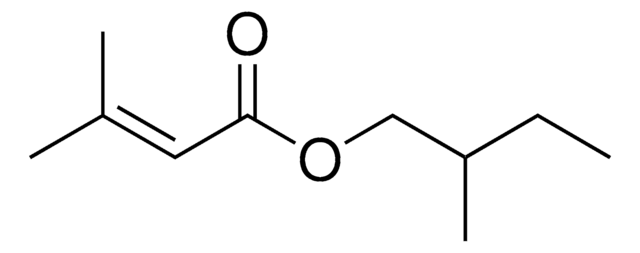W256102
cis-3-hexenal solution
50% in triacetin, stabilized
Sinónimos:
Disolución de (Z)-3-hexenal
About This Item
Halal
Kosher
Productos recomendados
origen biológico
synthetic
Nivel de calidad
grado
Fragrance grade
Halal
Kosher
Agency
follows IFRA guidelines
cumplimiento norm.
EU Regulation 1223/2009
FDA 21 CFR 117
contiene
α-tocopherol as stabilizer (synthetic)
concentración
50% in triacetin
índice de refracción
n20/D 1.44
bp
20 °C/0.2 mmHg
densidad
0.982 g/mL at 25 °C
aplicaciones
flavors and fragrances
Documentación
see Safety & Documentation for available documents
alérgeno alimentario
no known allergens
alérgeno de la fragancia
no known allergens
Organoléptico
apple; fatty; green; fruity
temp. de almacenamiento
2-8°C
cadena SMILES
CC\C=C/CC=O
InChI
1S/C6H10O/c1-2-3-4-5-6-7/h3-4,6H,2,5H2,1H3/b4-3-
Clave InChI
GXANMBISFKBPEX-ARJAWSKDSA-N
Categorías relacionadas
Aplicación
Cláusula de descargo de responsabilidad
Palabra de señalización
Warning
Frases de peligro
Consejos de prudencia
Clasificaciones de peligro
Eye Irrit. 2 - Flam. Liq. 3
Código de clase de almacenamiento
3 - Flammable liquids
Clase de riesgo para el agua (WGK)
WGK 3
Punto de inflamabilidad (°F)
96.0 °F
Punto de inflamabilidad (°C)
35.55 °C
Equipo de protección personal
Eyeshields, Faceshields, Gloves, type ABEK (EN14387) respirator filter
Elija entre una de las versiones más recientes:
¿Ya tiene este producto?
Encuentre la documentación para los productos que ha comprado recientemente en la Biblioteca de documentos.
Los clientes también vieron
Nuestro equipo de científicos tiene experiencia en todas las áreas de investigación: Ciencias de la vida, Ciencia de los materiales, Síntesis química, Cromatografía, Analítica y muchas otras.
Póngase en contacto con el Servicio técnico













